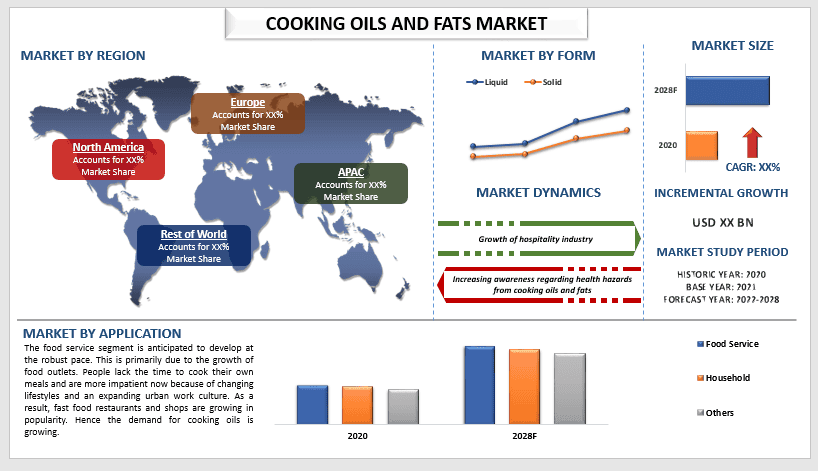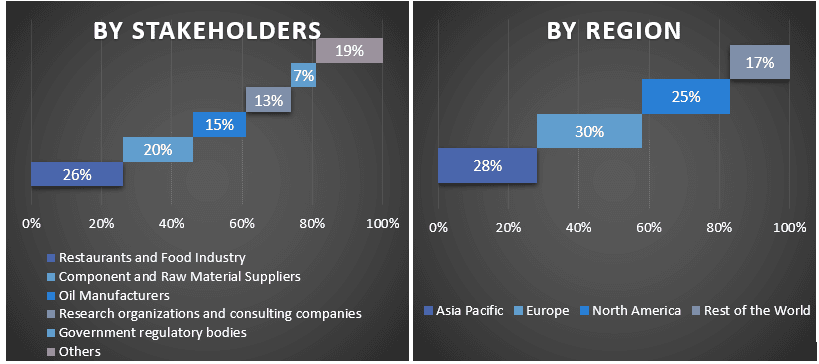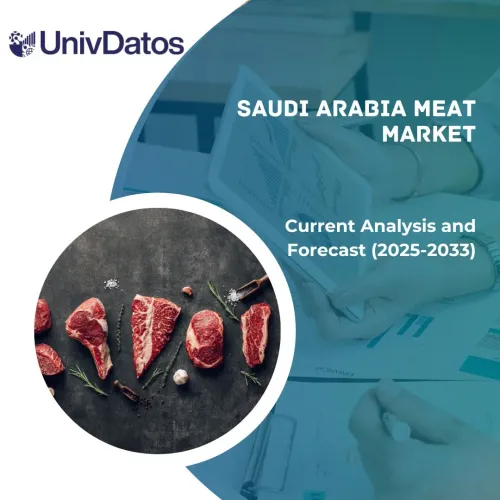- الرئيسية
- معلومات عنا
- صناعة
- الخدمات
- قراءة
- اتصل بنا
سوق زيوت ودهون الطهي: التحليل الحالي والتوقعات (2022-2028)
التركيز على نوع المنتج (زيوت نباتية وزيوت بذور، زيوت ودهون قابلة للدهن، زبدة، مارجرين، زيت زيتون، وغيرها)؛ الشكل (سائل وصلب)؛ قناة التوزيع (عبر الإنترنت وخارج الإنترنت)؛ التطبيق (خدمات الطعام، المنازل، وغيرها)؛ والمنطقة/البلد

من المتوقع أن يسجل سوق زيوت ودهون الطهي معدل نمو سنوي مركب قوي قدره 5٪ خلال الفترة 2022-2028. ويرجع ذلك في الغالب إلى ارتفاع الطلب على الأطعمة الجاهزة وتوسع الفنادق والمطاعم والمقاهي. يفتقر الناس إلى الوقت لطهي وجباتهم الخاصة وهم أكثر نفاد صبرًا الآن بسبب أنماط الحياة المتغيرة وتوسع ثقافة العمل الحضرية. ونتيجة لذلك، تزداد شعبية مطاعم ومحلات الوجبات السريعة. وبالتالي فإن الطلب على زيوت الطهي في ازدياد.
الوعي المتزايد بالتطورات في تدعيم الدهون والزيوت بالمعادن الإضافية، فضلاً عن كون الزيت النباتي أكثر صحة من نظيره، مما يقلل من خطر الإصابة بسرطان الثدي وأمراض القلب والأوعية الدموية. سيلعب صعود قطاع الأغذية في صناعة الضيافة، والذي يشمل الفنادق والمطاعم والمقاهي، فضلاً عن الطلب المتزايد على الأطعمة الجاهزة للأكل، دورًا في هذا التطور. وفقًا للبنك الدولي، يعيش 55٪ من سكان العالم - 4.2 مليار نسمة - في المدن. ومن المتوقع أن يستمر هذا الاتجاه. بحلول عام 2050، مع تضاعف عدد سكان الحضر أكثر من حجمه الحالي، سيعيش ما يقرب من 7 من كل 10 أشخاص في العالم في المدن. ستستمر عوامل مثل التحضر والتوسع الاقتصادي وزيادة عدد السكان من الطبقة المتوسطة في المساهمة في توسع سوق زيوت ودهون الطهي.
تعتبر Cargill Inc. و Archer Daniels Midland Company و Bunge Limited و Wilmar International Ltd. و Fuji Oil Company Ltd. و ConAgra Brands Inc. و IFFCO Group و Ottogi Co. Ltd. و Associated British Foods Plc و CJ Cheiljedang Corporation من اللاعبين الرئيسيين في السوق. وقد قامت هذه الشركات بالعديد من عمليات الاندماج والاستحواذ بالإضافة إلى الشراكات لتزويد العملاء بمنتجات / تقنيات مبتكرة وعالية التقنية.
الرؤى المقدمة في التقرير
"من بين أنواع المنتجات، استحوذت فئة الزيوت النباتية وزيوت البذور على الحصة الأكبر في السوق"
استنادًا إلى نوع المنتج، ينقسم السوق إلى الزيوت النباتية وزيوت البذور والزيوت والدهون القابلة للدهن والزبدة والسمن وزيت الزيتون وغيرها. استحوذت فئة الزيوت النباتية وزيوت البذور على حصة كبيرة من السوق بين فئات المنتجات. ويرجع ذلك في المقام الأول إلى حقيقة أنها أقل تكلفة وتفضل المطاعم والمقاهي الزيوت النباتية لتقليل نفقاتها. علاوة على ذلك، فإن انتشار منافذ بيع المواد الغذائية بسبب تزايد قاعدة المستهلكين من الوجبات السريعة هو أيضًا عامل مساهم في نمو سوق زيوت ودهون الطهي.
"من بين الأشكال، تعتبر الحصة السوقية للقطاع السائل أكبر بكثير"
استنادًا إلى الشكل، ينقسم السوق إلى قطاعات سائلة وصلبة. من بين هذه القطاعات، يتمتع القطاع السائل بحصة كبيرة. والسبب في ذلك هو أن الزيوت السائلة أسهل في التسخين والمعالجة ولها محتوى مائي أقل. علاوة على ذلك، تعتبر الدهون السائلة أكثر صحة من بديلاتها لأنها تحتوي على كميات أقل من الدهون المشبعة والمتحولة.
"منطقة آسيا والمحيط الهادئ ستشهد نموًا كبيرًا خلال الفترة المتوقعة"
من المتوقع أن تُظهر منطقة آسيا والمحيط الهادئ نموًا كبيرًا في سوق زيوت ودهون الطهي. المساهمون الرئيسيون في نمو هذا السوق هم دول مثل الهند والصين. ساهمت الزيادة في تطوير البنية التحتية في الاقتصادات الناشئة، فضلاً عن التحضر وزيادة عدد السكان من الطبقة المتوسطة، في نمو سوق منطقة آسيا والمحيط الهادئ. بالإضافة إلى ذلك، يتوسع السوق بسبب ارتفاع عدد العملاء الذين يبحثون عن خيارات غذائية مستدامة ومغذية بالإضافة إلى ارتفاع عدد محبي الرياضة واللياقة البدنية في المنطقة. بالإضافة إلى ذلك، يتأثر قطاع الزيوت الصالحة للأكل بشكل إيجابي بالتغيرات في نمط الحياة، وارتفاع عدد السكان من الطبقة المتوسطة، وزيادة معرفة المستهلك بمزايا اتباع نظام غذائي صحي.
أسباب شراء هذا التقرير:
- تتضمن الدراسة تحليلًا لحجم السوق وتوقعاته تم التحقق منه بواسطة خبراء الصناعة الرئيسيين الموثوق بهم.
- يقدم التقرير مراجعة سريعة للأداء العام للصناعة في لمحة.
- يغطي التقرير تحليلًا متعمقًا لأقران الصناعة البارزين مع التركيز الأساسي على البيانات المالية الرئيسية للأعمال ومجموعة المنتجات واستراتيجيات التوسع والتطورات الأخيرة.
- دراسة تفصيلية للمحركات والقيود والاتجاهات الرئيسية والفرص السائدة في الصناعة.
- تغطي الدراسة السوق بشكل شامل عبر قطاعات مختلفة.
- تحليل متعمق على المستوى الإقليمي للصناعة.
خيارات التخصيص:
يمكن تخصيص سوق زيوت ودهون الطهي العالمي بشكل أكبر وفقًا للمتطلبات أو أي قطاع سوق آخر. إلى جانب ذلك، تدرك UMI أن لديك احتياجات عملك الخاصة، لذا لا تتردد في التواصل معنا للحصول على تقرير يناسب متطلباتك تمامًا.
جدول المحتويات
منهجية البحث لتحليل سوق زيوت ودهون الطهي العالمية (2022-2028)
كان تحليل السوق التاريخية، وتقدير السوق الحالية، والتنبؤ بالسوق المستقبلية لسوق زيوت ودهون الطهي العالمية هي الخطوات الرئيسية الثلاث التي تم اتخاذها لإنشاء وتحليل اعتماد زيوت ودهون الطهي في المناطق الرئيسية على مستوى العالم. تم إجراء بحث ثانوي شامل لجمع أرقام السوق التاريخية وتقدير حجم السوق الحالي. ثانيًا، للتحقق من صحة هذه الرؤى، تم أخذ العديد من النتائج والافتراضات في الاعتبار. علاوة على ذلك، تم أيضًا إجراء مقابلات أولية شاملة مع خبراء الصناعة عبر سلسلة القيمة لسوق زيوت ودهون الطهي العالمية. بعد افتراض أرقام السوق والتحقق من صحتها من خلال المقابلات الأولية، استخدمنا نهجًا تصاعديًا / تنازليًا للتنبؤ بحجم السوق الكامل. بعد ذلك، تم اعتماد طرق تقسيم السوق وتثليث البيانات لتقدير وتحليل حجم السوق للقطاعات والقطاعات الفرعية التي تنتمي إليها الصناعة. تم شرح المنهجية التفصيلية أدناه:
تحليل حجم السوق التاريخي
الخطوة 1: دراسة متعمقة للمصادر الثانوية:
تم إجراء دراسة ثانوية تفصيلية للحصول على حجم السوق التاريخي لسوق زيوت ودهون الطهي من خلال مصادر داخلية للشركة مثل التقرير السنوي والبيانات المالية وعروض الأداء والنشرات الصحفية وما إلى ذلك، ومصادر خارجية بما في ذلك المجلات والأخبار والمقالات والمنشورات الحكومية ومنشورات المنافسين وتقارير القطاعات وقاعدة بيانات الطرف الثالث والمنشورات الموثوقة الأخرى.
الخطوة 2: تجزئة السوق:
بعد الحصول على حجم السوق التاريخي لسوق زيوت ودهون الطهي، أجرينا تحليلًا ثانويًا مفصلاً لجمع رؤى السوق التاريخية وحصتها للقطاعات والقطاعات الفرعية المختلفة للمناطق الرئيسية. تضمنت القطاعات الرئيسية المدرجة في التقرير نوع المنتج والشكل وقناة التوزيع والتطبيق. تم إجراء المزيد من التحليلات على مستوى الدولة لتقييم الاعتماد الكلي لنماذج الاختبار في تلك المنطقة.
الخطوة 3: تحليل العوامل:
بعد الحصول على حجم السوق التاريخي للقطاعات والقطاعات الفرعية المختلفة، أجرينا تحليلًا تفصيليًا للعوامل لتقدير حجم السوق الحالي لسوق زيوت ودهون الطهي. علاوة على ذلك، أجرينا تحليلًا للعوامل باستخدام متغيرات تابعة ومستقلة مثل أنواع المنتجات المختلفة والشكل وقناة التوزيع وتطبيق زيوت ودهون الطهي. تم إجراء تحليل شامل لسيناريوهات جانب الطلب والعرض مع مراعاة أهم الشراكات والاندماج والاستحواذ والتوسع التجاري وإطلاق المنتجات في قطاع سوق زيوت ودهون الطهي في جميع أنحاء العالم.
تقدير حجم السوق الحالي والتوقعات
تحديد حجم السوق الحالي: بناءً على رؤى قابلة للتنفيذ من الخطوات الثلاث المذكورة أعلاه، توصلنا إلى حجم السوق الحالي، واللاعبين الرئيسيين في سوق زيوت ودهون الطهي العالمية، والحصص السوقية للقطاعات. تم تحديد جميع الحصص المئوية المطلوبة وتقسيمات السوق باستخدام النهج الثانوي المذكور أعلاه وتم التحقق منها من خلال المقابلات الأولية.
التقدير والتنبؤ: لتقدير السوق والتنبؤ بها، تم تخصيص أوزان لعوامل مختلفة بما في ذلك المحركات والاتجاهات والقيود والفرص المتاحة لأصحاب المصلحة. بعد تحليل هذه العوامل، تم تطبيق تقنيات التنبؤ ذات الصلة، أي النهج التصاعدي / التنازلي، للوصول إلى توقعات السوق حول عام 2028 للقطاعات والقطاعات الفرعية المختلفة عبر الأسواق الرئيسية على مستوى العالم. تتضمن منهجية البحث المعتمدة لتقدير حجم السوق ما يلي:
- حجم سوق الصناعة، من حيث الإيرادات (بالدولار الأمريكي) ومعدل اعتماد سوق زيوت ودهون الطهي عبر الأسواق الرئيسية محليًا
- جميع الحصص المئوية وتقسيمات قطاعات السوق وقطاعاته الفرعية
- اللاعبون الرئيسيون في سوق زيوت ودهون الطهي العالمية من حيث الحلول المقدمة. أيضًا، استراتيجيات النمو التي اعتمدها هؤلاء اللاعبون للتنافس في السوق سريع النمو
التحقق من حجم السوق والحصة السوقية
البحث الأولي: تم إجراء مقابلات متعمقة مع قادة الرأي الرئيسيين (KOLs) بما في ذلك كبار المديرين التنفيذيين (CXO / VPs ورئيس المبيعات ورئيس التسويق والرئيس التشغيلي والرئيس الإقليمي ورئيس الدولة وما إلى ذلك) عبر المناطق الرئيسية. ثم تم تلخيص نتائج البحث الأولي وإجراء تحليل إحصائي لإثبات الفرضية المذكورة. تم دمج المدخلات من البحث الأولي مع النتائج الثانوية، وبالتالي تحويل المعلومات إلى رؤى قابلة للتنفيذ.
تقسيم المشاركين الأساسيين في مناطق مختلفة
هندسة السوق
تم استخدام تقنية تثليث البيانات لإكمال تقدير السوق الإجمالي والوصول إلى أرقام إحصائية دقيقة لكل قطاع وقطاع فرعي من سوق زيوت ودهون الطهي العالمية. تم تقسيم البيانات إلى عدة قطاعات وقطاعات فرعية بعد دراسة المعلمات والاتجاهات المختلفة في مجالات نوع المنتج والشكل وقناة التوزيع والتطبيق في سوق زيوت ودهون الطهي العالمية.
الهدف الرئيسي من دراسة سوق زيوت ودهون الطهي العالمية
تم تحديد اتجاهات السوق الحالية والمستقبلية لسوق زيوت ودهون الطهي العالمية في الدراسة. يمكن للمستثمرين اكتساب رؤى استراتيجية لارتكاز تقديرهم للاستثمارات من التحليل النوعي والكمي الذي تم إجراؤه في الدراسة. تم تحديد اتجاهات السوق الحالية والمستقبلية للجاذبية الإجمالية للسوق على المستوى الإقليمي، مما يوفر منصة للمشارك الصناعي لاستغلال السوق غير المستغلة للاستفادة كميزة المحرك الأول. تشمل الأهداف الكمية الأخرى للدراسات ما يلي:
- تحليل حجم السوق الحالي والمتوقع لسوق زيوت ودهون الطهي من حيث القيمة (بالدولار الأمريكي). أيضًا، قم بتحليل حجم السوق الحالي والمتوقع للقطاعات والقطاعات الفرعية المختلفة
- تشمل القطاعات في الدراسة مجالات نوع المنتج والشكل وقناة التوزيع والتطبيق.
- تحديد وتحليل الإطار التنظيمي لصناعة سوق زيوت ودهون الطهي.
- تحليل سلسلة القيمة المتضمنة مع وجود وسطاء مختلفين، إلى جانب تحليل سلوكيات العملاء والمنافسين في الصناعة.
- تحليل حجم السوق الحالي والمتوقع لسوق زيوت ودهون الطهي للمنطقة الرئيسية.
- تشمل الدول الرئيسية في المناطق التي تمت دراستها في التقرير آسيا والمحيط الهادئ وأوروبا وأمريكا الشمالية وبقية العالم.
- ملفات تعريف الشركة لسوق زيوت ودهون الطهي واستراتيجيات النمو التي اعتمدها اللاعبون في السوق للاستمرار في السوق سريع النمو
- تحليل متعمق على المستوى الإقليمي للصناعة
ذات صلة التقارير
العملاء الذين اشتروا هذا المنتج اشتروا أيضًا










